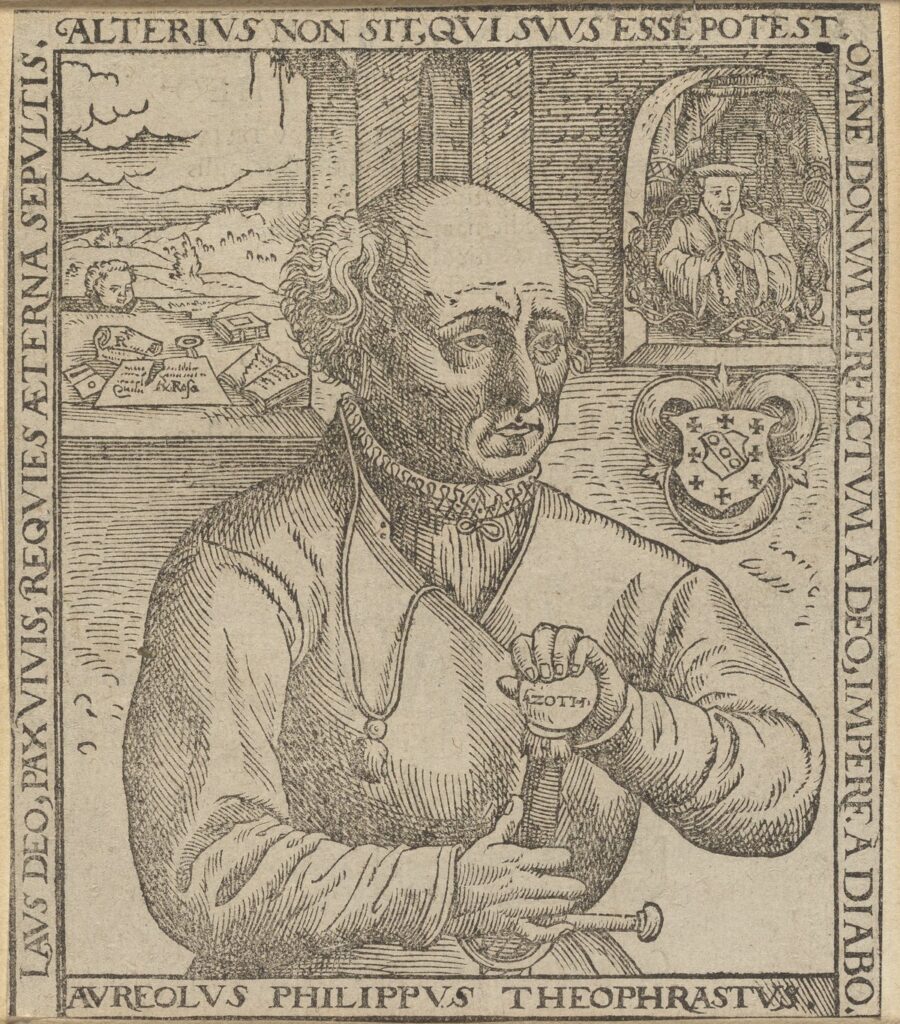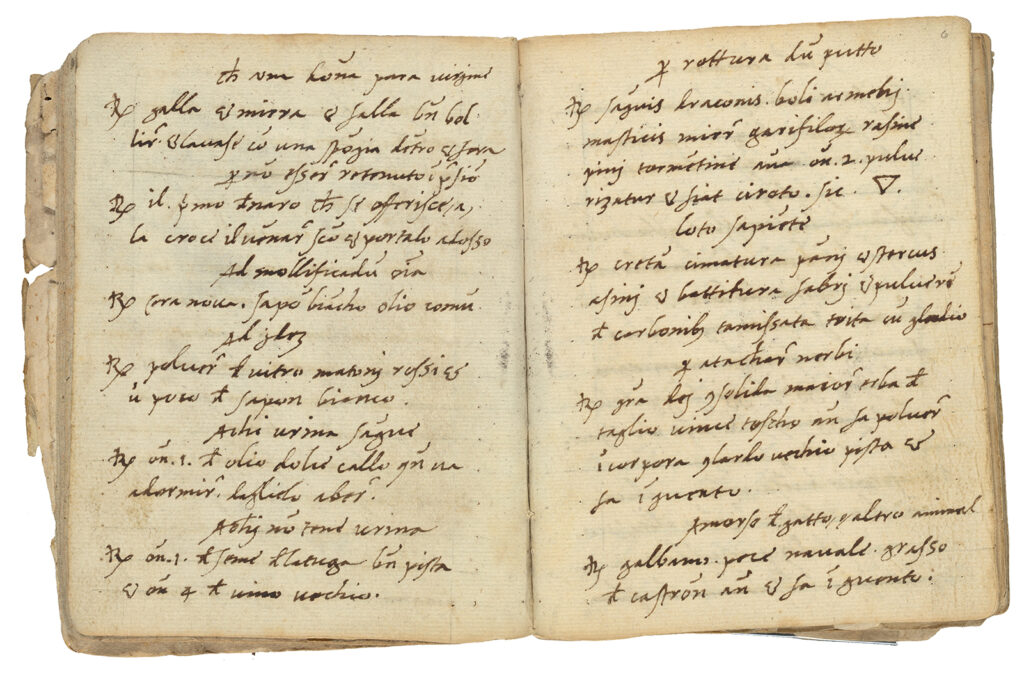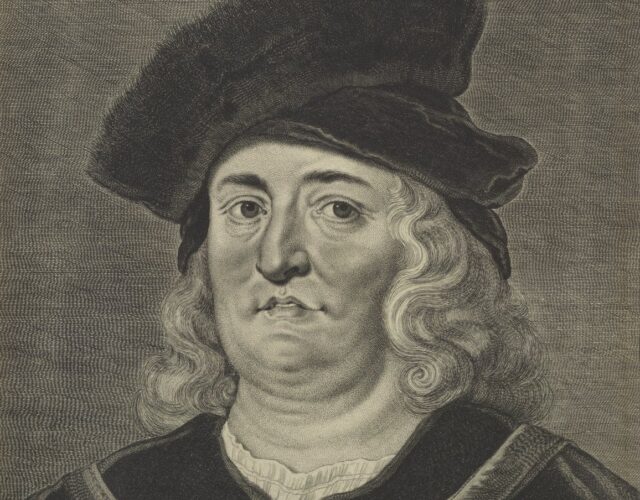Bruce T. Moran. Paracelsus: An Alchemical Life. Reaktion, 2019. 216 pp. $22.50.
Sci-fi pioneer and futurist Arthur C. Clarke famously declared that “any sufficiently advanced technology is indistinguishable from magic.” This statement might also suggest that magic, sufficiently studied, could conveniently reveal itself to be science. For people who are, like myself, fascinated by alchemy, this thinking can be a tempting trap. We recognize—with the clarity of both hindsight and our knowledge of the atom—that lead cannot become gold (at least not without a particle accelerator), and so we might look back with something like embarrassed discomfort at those who attempted this transmutation. The easiest way to avoid this sensation is to reframe alchemists as otherwise modern chemists trapped in an era before Pyrex and the periodic table—not delusional or fraudulent, merely temporally unlucky. That way, alchemists’ messier and more mystical impulses become relatively palatable—just the inescapable background noise of their era masking otherwise straightforward advances in materials science.
The truth of what alchemists believed—and what those beliefs drove them to attempt—is harder to grapple with, as Bruce Moran’s intimate new biography of Paracelsus confirms. The life and writings of the Swiss-born, German-speaking physician-alchemist Theophrastus von Hohenheim, better known as Paracelsus (ca. 1493–1541), stubbornly resist strict categorization and demystification. Paracelsus’s most widely embraced theories (particularly his argument for targeted drugs that would attack a disease rather than merely rebalance the humors) have given him a lingering reputation as a rational, reforming empiric who emerged from the so-called demon-haunted world. Moran intentionally complicates that reputation: Paracelsus dealt simultaneously with theology, medicine, humanity, chemistry, and magic, and saw each of these as united to and vitally enriched by the others. He understood human beings as a “microcosm, a condensation of the entire universe.” Exploring the human body and what plagued or healed it was a means of exploring all of creation, even the supernatural realm. As science writer Philip Ball notes in his 2006 biography The Devil’s Doctor, Paracelsus’s work “begins and ends in magic.” Ball goes further, stating that “Paracelsus did not do science,” and in a modern sense this is certainly true. Yet both Ball’s and Moran’s biographies demonstrate how magic and emergent science were once woven into a coherent worldview—one that still has much to teach us.
The protean Paracelsus has historically been ripe for other people’s interpretations. Moran notes the many different labels he has been retroactively saddled with: “lonely genius . . . Romantic hero . . . martyr . . . religious militant . . . Utopian rebel,” one among “the many ‘fathers’ of enlightened medical practice.” Paracelsus was even coopted by the Nazi regime as a nationalist idol. “But,” Moran writes, “we can only really know him on his own terms.” Considering the many gaps in the historical documentation on Paracelsus, Moran often lets his subject speak for himself, relying whenever possible on Paracelsus’s own writings. The key text here is the posthumously published Seven Defenses, which Moran calls “seven windows” through which to view the alchemist.

Here are a few things we do know about Paracelsus: he was born in the Swiss village of Einsiedeln, the result of a mixed-class marriage between the illegitimate son of nobles and a bond servant of a nearby cloister. His mother’s status rendered Paracelsus a “semi-serf”: even at his death his belongings were subject to claims by the local church authorities who had once owned his mother’s labor. Moran argues convincingly that Paracelsus’s origins—which burdened him socially and professionally even as he rose to international fame—are crucial to understanding his persona as a self-made man and iconoclastic thinker. Moran also notes that multiple portraits of Paracelsus made during his lifetime bore the inscription or motto “alterius non sit qui suus esse potest,” commonly translated as “let him not be another’s who can be his own.” But Moran subtly rewords it as “let him not belong to another who is able to possess himself.”
Paracelsus’s father, Wilhelm, was a physician who encouraged his son in the study of Latin and medicine. Supposedly, Paracelsus later traveled to Italy to continue those studies at the respected medieval university in Ferrara, but no records confirm his attendance. Once again, as Moran puts it, “Paracelsus sometimes made himself up.” He settled in Strasbourg after several years of wandering—during which he claimed to have endured captivity by Tatars in Moscow, among other adventures—and began receiving patients. His popularity as a physician grew quickly, and he was invited to take up the post of city physician in Basel around 1527. This position also came with the rank of professor at Basel’s medical college, then a bastion of traditional Galenic humoral theory, which Paracelsus rejected and agitated against. In his view the university’s stubborn adherence to humoral theory’s ancient pedigree, its insistence on the core practices of purging and bloodletting—thought to restore the equilibrium of the four bodily humors—and its rejection of new empirical work using chemistry and anatomy all rendered its teachings outmoded. If physicians wanted answers, Paracelsus entreated them to read the “book” of nature rather than only the texts of Galen. Not surprisingly, Paracelsus’s colleagues in Basel were less than enthusiastic about his critiques, and although he was a faculty member, they denied him space to lecture. Paracelsus being Paracelsus, however, he was not deterred: he took on students anyway, delivering lectures in whatever off-site spaces he could find. As a further dig at the medical establishment, Paracelsus apparently gave his lectures not in Latin—the language of the university—but in common German.
Soon unwelcome in Basel, Paracelsus made his way to Nuremberg, where he resumed work as a physician—though he rarely settled for long. Amid his travels he continued writing treatises on medicine. These works expounded on the body’s “internal” alchemist—that is, its capacity for separating out what was useful and what was harmful from what it consumed—and on his belief that diseases originate from contact with materials or contagions outside the body rather than from internal imbalances. His suggested remedies often included novel or familiar-but-transformed substances, such as his creation of a new tincture of opium for pain, a compound he named laudanum. His belief in treating “like with like” sometimes meant embracing materials considered harmful: to fight the ravages of leprosy he promoted an “oil of antimony,” a known poison also used in metal alloys. Rather than seeking wellness through a harmonic inner balance, Paracelsus advocated targeting and attacking illness in the specific regions affected—by any means necessary.
At times those means included magic. While much of what Paracelsus explores seems utterly rational (if not obvious) to contemporary minds in a pharmaceutical-rich world, he also engaged deeply with theology, mysticism, and superstition. In his examinations of St. Vitus’s dance (a condition marked by an uncontrollable jerking and trembling of limbs, now called Sydenham’s chorea), Paracelsus referred to it as an “imaginative sickness,” for which he recommended treatments that ran from abstinence and fasting to the destruction of a poppet doll created in the victim’s likeness, which would likewise destroy the roots of the sickness. For Paracelsus, mastering chemical as well as magical cures was crucial to understanding illness and wellness. It was also a matter of Christian duty: he felt “human beings needed to know what the Devil knew . . . [including] the kind of knowledge that the Devil misapplied.” First on this list was magic, originated by God but misused by demons and necromancers. Reclaiming magic in the service of humanity, to heal and comfort, was the physician’s calling.

Not everyone agreed with Paracelsus’s ideas. Attacks against him in his own time were vitriolic: mocking poems circulated in Basel referred to him as “Cacophrastus” (a scatological pun on his given name) and his teachings as “peasant wisdom.” He was accused of inventing new medicines in defiance of ancient authority; needlessly generating new names for diseases; using alchemically manufactured drugs, even poisons, to supplant traditional herbal cures; and being a poor ethical model for a physician owing to his coarseness, itinerant lifestyle, and lack of humility.
Charmingly, Paracelsus often embraced the accusations against him, acknowledging (with pride) he was indeed cut from “coarse cloth,” he was untethered to place or position, and his ideas were unusual, even revolutionary. In his Seven Defenses, which Moran explores in depth, Paracelsus argues that those things that set him apart from other physicians were precisely the foundations of his specialized knowledge. “Do not despise my writings . . . because I am solitary, because I am new, or because I am German,” he cautions. The itinerant doctor, he argues, encounters a wider kind of expertise, practiced by midwives and barber-surgeons as well as bathhouse attendants and artisans, and so learns about a wider range of illnesses and cures. The physician who embraced alchemy could “perfect” nature for the benefit of humankind and even transform dangerous poisons into agents of healing. The doctor who looked beyond the single body and its humors—outward to nature, to the cosmos and beyond—could gain a larger picture and better understand the path to true wellness.
While Paracelsus’s self-defenses are skillful and convincing, Moran reminds his readers that Paracelsus consciously created and maintained his own persona—and that there is a danger in hewing too closely to your subject’s own views about himself. But ultimately the undeniable appeal of Paracelsus lies not only in his rationality and his contributions to medicine but in his refusal to adhere to anyone’s standards. While his theories of targeted cures helped shape the emergence of the modern pharmaceutical industry and his serious explorations of poisons made invaluable contributions to toxicology, Paracelsus’s embrace of magic was as sincere and as deeply embedded as any other aspect of his practice. It can’t be stripped away—and he wouldn’t thank us for trying. His was a world in which magicians could heal and wandering alchemists could read nature like a book. Where we might see uneasy dichotomy, Paracelsus frequently saw fertile correspondence: mysticism and empiricism beautifully joined.
In his thoughtful way Moran also invites us to consider other questions, such as our own world’s insistent divisions between rationality and subjectivity, science and healing. Paracelsus’s life reminds us to be “at home in the world,” as the itinerant physician was, and to “acknowledge . . . the insights and experiences of all kinds of people,” presumably including those who, like Paracelsus, are foreigners, travelers, workers, and iconoclasts. The diversity of ideas and influences he embraced—and in turn the complexity and endurance of his legacy—are testament to the wondrous contradictions of his messy, inventive, restless, alchemical life.




